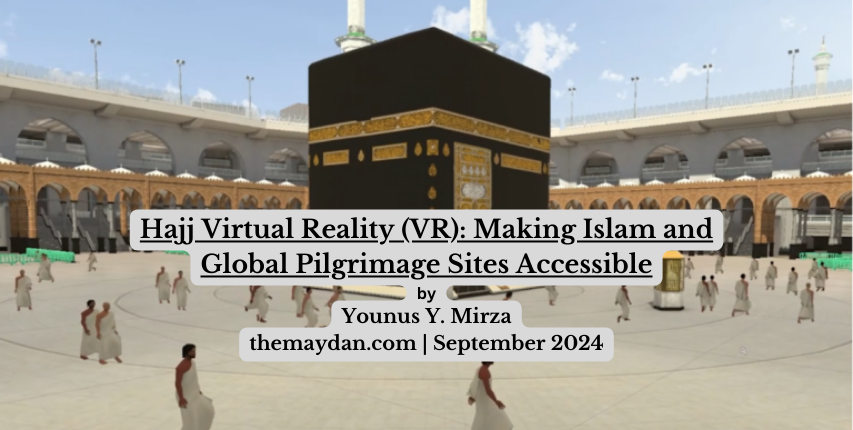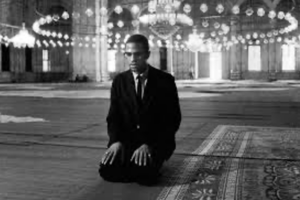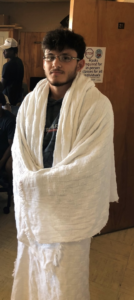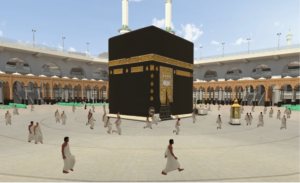
Westerners have long been fascinated with the Hajj, writing memoirs on their journey to Mecca and describing how they managed to enter the space.[1] For many pilgrims, the Hajj represents an original and primordial state that emphasizes the oneness of God and human equality, which contrasts with the perils of modern life and its various challenges. Europeans often traveled to Mecca through conversion or disguise to better understand the ritual and interact with the worldwide Muslim community. For instance, the French Richard Francis Burton made Hajj in 1853, pretending to be a “Pathan,” or somebody born in India to Afghan parents who had settled in the country and sent out as a wanderer. He further “assumed the polite, pliant manners of an Indian physician, and the dress of a small Effendi (or gentle-man)” while still representing himself as a Darwaysh and congregating where the group did.[2] For these Westerners, Mecca and the Hajj symbolically represent Islam, the impenetrable place that seems far, distant, and unintelligible but also close, intriguing, and captivating. However, with the advent of technology, Mecca and the Hajj have become more accessible than ever, with students and faculty now being able to enter and roam the space through virtual reality.[3]
How I Taught the Hajj, the Pilgrimage of Islam
Many of my students noted that the experience was unique in that they felt they were in Mecca in a way that a documentary or piece of writing doesn’t necessarily allow.During my courses on Islam, I introduce my students to the Hajj or the pilgrimage to Mecca. I usually have my students watch a documentary about the pilgrimage and show slides on the various rites.[4] I then transition to discuss personal experiences and memoirs from the Hajj such as Malcolm X’s famous Letter from Mecca where he shares how the pilgrimage made him rethink his views on race and relationship to white people. The Letter frequently opens doors to discuss race on campus and how travel can help broaden one’s world and challenge stereotypes. Last, I speak about how the Hajj has become an “American experience,” with the word “Mecca” being found in most English dictionaries as a place of gathering and how many school districts are taking off Eid because of their growing Muslim populations. Throughout the presentation, I make sure to talk about my own Hajj experiences, such as the various challenges I faced while there and how they helped me think through my personal life and career decisions. To make the pilgrimage more “real”, I have a student volunteer wear a pilgrimage garment (Ihram) so they can see what it might be like to be a pilgrim. I also bring snacks and desserts from the Middle East, such as dates and baklava, so they can experience the local food and culture.

Moreover, I have been guest lecturing in my colleague’s classes since there is a larger fascination with the Hajj, especially in the travel and pilgrimage experience. For instance, for several years I have been speaking in Shenandoah University’s First Year Seminar course “Walks and Pilgrimages” taught by our President Tracy Fitzsimmons and Director of the Center for Global Education Bethany Galipeau-Konate. The class surveys pilgrimages all over the world and has guest lecturers speak about their various experiences, such as walking the Camino. The First Year Seminar program slogan is “Going Global,” so the course is an excellent way for students to learn about global cultures and how various religious and spiritual experiences connect with them.

Hajj VR
However, this last year I was able to take my students to Mecca with virtual reality made possibility through a remarkable partnership between the Center for Islam in the Contemporary World (CICW), Shenandoah University’s Virtual Reality Department, Barzinji Institute for Global Virtual Learning and Siraj Studios in Jordan.[5] Students can now put on a headset and turn on the “roaming” feature which allows students to explore the sanctuary, teleport to different parts of the grand mosque and even perform aspects of the pilgrimage. For instance, students can walk around the Ka‘ba and run between the mountains of Safa and Marwa, alongside AI generated pilgrims. As they explore, large “information” buttons appear which they can click on to learn more about the sites they are seeing. Students can further hear the supplications given at Hajj and overhear other pilgrims’ voices and prayers. A student’s view can be projected onto a larger screen so the other students can see what they are experiencing and even suggest what to do next. It made pilgrimage more “real” as something they could personally simulate and experience first-hand.[6]
Educators may be intimidated by the new technology and its costs, but virtual reality headsets are becoming more ubiquitous, especially with younger generations, and have become cheaper within the market. Many institutions also have technology labs with VR sets available to use or check out. For instance, I have had my students use Pilgrim VR in our classroom but I have also taken them to our VR lab so more of them could try the experience. Moreover, there may be a concern about the virtual experience replacing the actual Hajj but the application is explicit that it is for educational purposes and does not substitute for the actual pilgrimage.

Making Travel and World Religions Accessible
Technology is further important as it increases students’ accessibility to global and international sites, which is due to the increased attention to making international education universal. Only a fraction of American students can study abroad, mainly because of finances and busy academic schedules. This low number translates into Americans being unaware of how they fit within the world and unfamiliar of global politics and culture. Opportunities through virtual reality, virtual exchange, and Collaborative Online International Learning (COIL) make interacting with international cultures and visiting various global sites open to those who may not have the opportunity otherwise. It may further spur students to consider study abroad, spring break trips, and faculty-led travel programs.[7]

Moreover, Islam is often viewed as a foreign and distant religion, one that resides in the Middle East and in arid and inaccessible climates. For many American students, places like Mecca may seem far and irrelevant even if thousands of Americans make the pilgrimage yearly. VR technology now allows Islam and its rites to become more real since students can experience the pilgrimage rather than see it through pictures and videos.
The technology can thus help break stereotypes of Islam and Muslims by making their religion more comprehensible and accessible.
Conclusion
Pilgrim VR represents a new level in teaching about pilgrimage and the Hajj by allowing students to visit Mecca virtually and explore the various sites. Traditional methods of documentaries and personal memoirs can now be complemented with immersive technology, enabling the students to feel what it might be like to be in Mecca. Instead of just learning about the Hajj, students can now visit Mecca through virtual reality and see and experience the place for themselves. The technology thus has a dual purpose of having students learn about one of the world’s largest religions while encouraging them to travel and explore first-hand global religious and spiritual pilgrimage sites.
Younus Y. Mirza is a Visiting Researcher at Georgetown University and Director of the Barzinji Institute for Global Virtual Learning at Shenandoah University which seeks to improve America’s relationship with Muslim-majority countries. He is currently writing a book about the Islamic Mary. To learn more about his scholarship, teaching and speaking, please visit his website http://dryounusmirza.com
[1] The Hajj and Europe in the Age of Empire, ed. Umar Ryad (Leiden; Boston: Brill 2017).
[2] Francis E. Peters, The Hajj: The Muslim Pilgrimage to Mecca and the Holy Places (Princeton, N.J. : Princeton University Press, 1994), 217.
[3] As Gary Bunt states, “There is no need for those staying at home to not feel part of the Hajj”; “Decoding the Hajj in Cyberspace,” in The Hajj: Pilgrimage in Islam, edited by Eric Tagliacozzo and Shawkat Toorawa (New York, NY: Cambridge University Press, 2016), 249.
[4] For an overview of the various rites and their meanings, see Shawkat Toorawa, “Performing the Pilgrimage,” in The Hajj: Pilgrimage in Islam.
[5] Dominik Schlosser, “Digital Hajj: The Pilgrimage to Mecca in Muslim Cyberspace and the Issue of Religious Online Authority,” Scripta Instituti Donneriani Aboensis 25, (2013): 189–203.
[6] The technology can also be used to train pilgrims before they travel to Mecca. However, only a small percentage of Muslims will be able travel to Mecca because of the cost and logistical challenges making the virtual experience even more valuable. Of course, the VR experience does not replace the real Hajj. For more on teaching the Hajj to potential pilgrims see Alaa Alsaif, “Teaching the Hajj using Virtual Simulation Technology with Middle School Students in Saudi Arabia,” Journal of Education of the Faculty of Pedagogy 33, (2017): 27-58.
[7] Many of my students do not have a passport and have not considered studying or traveling outside the United States. Moreover, Mecca is reserved for Muslims pilgrims making it difficult if not impossible for interested non-Muslims to visit the site.

